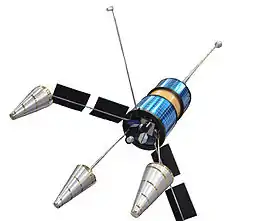 A Gonets-M satellite at Salon du Bourget in 2013. | |
| Manufacturer | NPO Prikladnoi Mekhaniki |
|---|---|
| Country of origin | Russia |
| Operator | Gonets SatCom (1996-present) Roscosmos (1992-1996) |
| Applications | Communications |
| Specifications | |
| Bus | Gonets |
| Launch mass | 233 to 280 kg |
| Power | 40 watts from solar panels |
| Batteries | Nickel-hydrogen |
| Equipment | UHF transponders [1] (B-band / D-band) Data rate up to 64 kbit/s |
| Regime | Low Earth orbit |
| Design life | 5 years (planned) |
| Dimensions | |
| Production | |
| Status | Active |
| Related spacecraft | |
| Derived from | Strela |
Gonets (Russian Гонец, for Messenger) is a Russian civilian low Earth orbit communications satellite system. It consists of a number of satellites, derived from Strela military communications satellites. The first two satellites, which were used to test and validate the system, were launched by a Tsyklon-3 launch vehicle from the Plesetsk Cosmodrome on 13 July 1992,[2] and were designated Gonets-D.[3] The first operational satellites, designated Gonets-D1, were launched on 19 February 1996.[3] After launch, the first three satellites were given military Kosmos designations, a practice which was not continued with the other satellites.[2]
Ten operational satellites and two demonstration spacecraft have been placed in orbit. A further three were lost in a launch failure on 27 December 2000. A new series of modernised Gonets satellites, Gonets-D1M, supplement and replace the satellites which are currently in orbit. A single first D1M satellite was launched by a Kosmos-3M launch vehicle on 21 December 2005.[4] A second Gonets-D1M satellite was launched by a Rokot launch vehicle on 8 September 2010.[4]
Operator
Gonets satellites are operated along with the third generation Luch satellites by Gonets Satellite System company. Gonets was originally a Roscosmos programme, but in 1996 it was privatised and operated by Gonets Satellite System,[5] which was controlled by ISS Reshetnev.[6] In 2017, Roscosmos acquired 80% of Gonets SatCom from ISS Reshetnev. The remaining 20% were held by Dauria Satcom.[7] By 2018, Dauria Satcom sold the shares to Business-Sfera of Coalco group while Roscosmos sold 29% to other private investors. Gonets SatCom has become a Russian space industry company with the largest (49%) share of private capital.[8]
User characteristics
As of 2016, the Gonets orbit group comprises 25 second-generation spacecraft "Gonets-M" and 1 first-generation "Gonets-D1". The orbital group performs the task of direct communication with subscribers at any point of the globe. With such a number of spacecraft in the Gonets orbit group, the system provides communication with waiting time characteristics as indicated in the following table. The next 3 Gonets-M satellites will be launched in 2022 by an Angara-1.2 launcher from the Plesetsk cosmodrome.[9]
| City, location | latitude | Session probability = 0.9 Waiting time | Session probability = 0.8 Waiting time | Session probability = 0.7 Waiting time |
|---|---|---|---|---|
| Meru, Kenya | 0° | 25.04 min | 19.98 min | 13.54 min |
| Fuli, Vietnam / Vitoria, Brazil | 20° / −20° | 19.47 min | 14.97 min | 8.85 min |
| Yerevan, Armenia / Wellington, New Zealand | 40° / −40° | 17.79 min | 12.04 min | 6.08 min |
| Belgorod, Russia / Isla Duque de York, Chile | 50° / −50° | 15.00 min | 8.19 min | 2.17 min |
| Vyborg, Russia / Orcadas Antarctic Station | 60° / −60° | 5.64 min | 1.78 min | 0.00 min |
| Kara Gate Straight, Barents Sea / Novolazarevskaya Station, Antarctic | 70° / −70° | 3.45 min | 0.00 min | 0.00 min |
| Gall Island, North Arctic Ocean / Antarctic Kunlun Station | 80° / −80° | 0.00 min | 0.00 min | 0.00 min |
| North Pole / Amundsen–Scott South Pole Station | 90° / −90° | 0.00 min | 0.00 min | 0.00 min |
Technical characteristics of subscriber terminals 0.3–0.4 GHz
| Transmitter power | 8–10 W |
| Positioning accuracy by GPS/GLONASS | up to 10 m |
| Modulation | GMSK |
| Power supply | AC 220 V, DC 12 V |
| Weight | 100–300 g |
| Bitrates: "Subscriber – Satellite" | 2.4–9.6 kbit/s |
| Bitrates: "Satellite – Subscriber" | 9.6–76.8 kbit/s |
See also
References
- ↑ "GONETS". Small Satellites Home Page. Surrey Satellite Technology Ltd. Archived from the original on 9 July 2008.
- 1 2 Wade, Mark. "Strela". Encyclopedia Astronautica. Archived from the original on 26 May 2008.
- 1 2 Krebs, Gunter. "Gonets". Gunter's Space Page. Retrieved 8 September 2010.
- 1 2 Krebs, Gunter. "Gonets-M". Gunter's Space Page. Retrieved 8 September 2010.
- ↑ "Leosat system "Gonets"". Gonets SatCom. Archived from the original on 10 May 2008.
- ↑ "Investors - GONETS Leosat system". gonets.ru. Archived from the original on 16 April 2016.
- ↑ ""Гонца" отправили в "Роскосмос"" [Messenger has been sent to Roscosmos] (in Russian). Kommersant. 19 April 2017.
- ↑ "Акционер достиг "Гонца"" [A shareholder has reached the Messenger] (in Russian). Kommersant. 23 March 2018.
- ↑ "Источник сообщил о планируемом запуске спутников "Гонец-М" ракетой "Рокот"" [Source informed about planned launch of Gonets satellites on Rokot] (in Russian). RIA Novosti. 13 February 2019. Retrieved 28 April 2021.